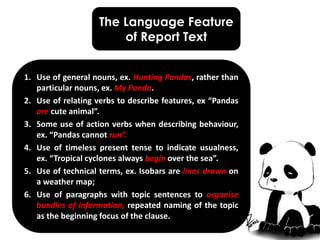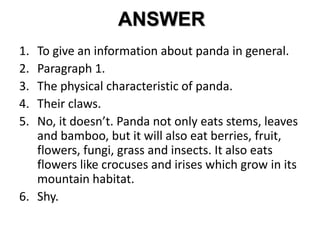Report text about animal (panda)
- 1. Report Text Nada Salsabilah.(9.3/01) Yuliana Dewi S. (9.3/03)
- 2. “ Report text is a text which present information or describe about something in general. Usually, it is a result of systematic observation and analyses." The Definition of Report Text
- 3. The Generic Structure of Report Text 1. General Clasification » statements that describe the common subject of the report, common description, and classification. 2. Description » Tells what the phenomenon under discussion; in terms of parts, qualities, habits or behaviors; This section gives us an overview of commonly occurring phenomenon, either of its parts, its properties, habit, or behavior. The point is, presenting elaboration of scientific classification. There are also some information on the generic structure, which includes : 1) General information, is the part that mentions the general information of the theme of writing. 2) Bundles of Specific Information, give us the elaboration of general information.
- 4. The Purpose of Report Text The purpose of report text is to present information about something. It usually describes an entire class of things or describes things in general way, whether natural or man-made like mammals, the planets, rocks, plants, countries of region, culture, transportation, and so on.
- 5. The Language Feature of Report Text 1. Use of general nouns, ex. Hunting Pandas, rather than particular nouns, ex. My Panda. 2. Use of relating verbs to describe features, ex “Pandas are cute animal”. 3. Some use of action verbs when describing behaviour, ex. “Pandas cannot run”. 4. Use of timeless present tense to indicate usualness, ex. “Tropical cyclones always begin over the sea”. 5. Use of technical terms, ex. Isobars are lines drawn on a weather map; 6. Use of paragraphs with topic sentences to organise bundles of information, repeated naming of the topic as the beginning focus of the clause.
- 7. PANDA
- 8. Many people have known this tame and cute animal. It called panda. Pandas are mammals. They are tame animal and they are kind of raccoon. Originally, pandas lived in South and East China and parts of Myanmar and Vietnam. Today, pandas are found in six isolated forest areas in Sichuan, Gansu, and Shaanxi provinces in China. Pandas live in high mountainous areas, usually from 2,700 to 3,700 meters (8,500 to 11,500 feet) above sea level, that have natural forested areas with fir, spruce, and bamboo. Pandas have a white coat with black fur around their eyes, on their ears, muzzle, legs and shoulders.Its weight about 100-150kg. Many people think that the pandas only eats stems, leaves and bamboo, but it will also eat berries, fruit, flowers, fungi, grass and insects. It also eats flowers like crocuses and irises which grow in its mountain habitat. In the wild it will also catch fish and hunt small birds and rodents, like bamboo rats. This is not enough to live on, though, so it mainly eats various species of bamboo. Pandas have claws to protect their selves from danger.
- 9. They can also swim and climb trees. But when panda have a defent it can certainly fight back Giant pandas will display aggression by lowering their heads and staring directly at the opponent. Because of its size and strength, a panda is a potentially frightful and awesome beast. But its clumsy and uncoordinated ways make it an awkward and defensive creature. It fumbles along, pigeon-toed, in an ungraceful, diagonal walk. It is rarely urged from this lumbering pace. Only a young panda, or a panda in desperate flight, will venture to climb a tree. And once it has reached the top, it becomes an even greater task to get down. Despite its aloof manner and clumsiness, the giant panda has won a reputation as a loving and adorable creature. With its big, furry head, gentle, flat face, and dark-ringed, sad-eyes, the giant panda is irresistible. Its lopsided movements and its timidity have endeared it to countless friends and admirers at zoos around the world.
- 10. QUESTION 1. What is the language function of the text above? 2. In which paragraph that tells about the general classification of the report text above? 3. What is the main idea of paragraph 2? 4. Which is the part of panda’s body that has a function to protect their self from danger? 5. Does pandas only eat bamboo ? Why? 6. “Its lopsided movements and its timidity“(paragraph 4) what is the synonym of the underlined word? 7. What makes the giant panda become irresistible?
- 11. ANSWER 1. To give an information about panda in general. 2. Paragraph 1. 3. The physical characteristic of panda. 4. Their claws. 5. No, it doesn’t. Panda not only eats stems, leaves and bamboo, but it will also eat berries, fruit, flowers, fungi, grass and insects. It also eats flowers like crocuses and irises which grow in its mountain habitat. 6. Shy.












